Exclusive first look: the Eriksberg collection, by Bernadotte & Kylberg, is a royally sumptuous Swedish affair
A new furniture collection by Bernadotte & Kylberg takes its cues from Swedish craft and countryside
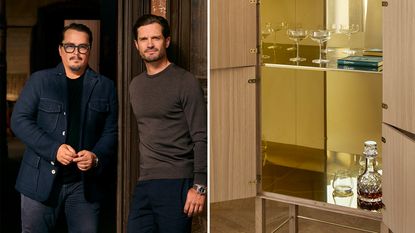

The Swedish design duo Bernadotte & Kylberg has unveiled a new collection of furniture, born from the pair’s design of the new Eriksberg Hotel at Arken in the south of Sweden. The collection - consisting of a cabinet, a writing desk and a chair – combines a palette of local natural materials with a distinctly Swedish sense of refinement that dances between classicism and modernity. Timelessness is a word thrown about with abandon in the realm of design, but in the case of the Eriksberg collection, these are beautiful works that sit above taste and beyond trend.
The Eriksberg collection byBernadotte & Kylberg
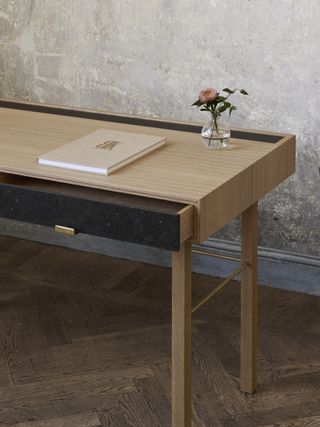
The writing desk and chair in the Eriksberg collection echo the same luxurious materials—solid oak, diabase, and brass—creating a workspace that's as inspiring as it is functional.
The Eriksberg cabinet is solid oak with doors made from diabase stone, quarried at nearby Biskopsgården in the northeastern part of Skåne, finished with brass details and lined with a brass interior. The writing desk and chair are made from the same oak, with a diabase stone frontage on the desk and brass handles. The chair is softened with an upholstered leather seat. The collection comes in natural oak, and also in a Crimson and Ivy hue, in a nod to Sweden’s historic, if lesser-known, relationship with rich colour. In addition to the Eriksberg collection, Bernadotte & Kylberg are also launching the Tulip – a solid polished brass tealight holder also handmade in Sweden. The handsome Tulip has been reduced to the essence of the flower’s form to become something delicate and graphic simultaneously.
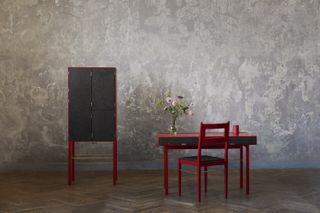
The Eriksberg Cabinet Writing Desk and Chair in Crimson
Bernadotte & Kylberg was formed in 2012 by Carl Philip Bernadotte and Oscar Kylberg. In the 12 years since, they have designed for an impressive portfolio of brands including Hästens, Skultuna, Georg Jensen, Stelton and Zwiesel, in each case demonstrating a flair for materiality and charm with restraint. It is worth noting that Carl Philip is also the prince of Sweden and, as the pair allude to in our conversation, this comes with added scrutiny towards their work. Perhaps this is where the attractive modesty in their design language comes from. There is a quiet sensibility in the duo’s expression, which speaks for itself.
That said, as the Eriksberg collection comes to market, we sat down with Carl Philip Bernadotte and Oscar Kylberg to hear more about their latest project and how they work together.
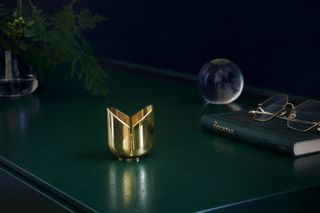
The Tulip is a solid tealight holder, made from polished brass and handcrafted in Sweden
Wallpaper*: Congratulations on the beautiful new collection. Tell me about some of the cues that have inspired you?
Oscar Kylberg: We were tasked with creating the whole interior concept for the Eriksberg Hotel and we wanted to bring as many local materials into the design as possible, blurring the boundaries between inside and outside.
Carl Philip Bernadotte: It’s a particular part of Sweden with a special landscape, so it felt natural to use what exists nearby, for materials and skills, to root the interior experience in its local context. It’s a way of making the property ‘of place’.
Wallpaper* Newsletter
Receive our daily digest of inspiration, escapism and design stories from around the world direct to your inbox.
W*: Where do the wonderful colours come in?
OK: When people think of Swedish design they usually associate our tradition as quite clean, streamlined, industrialised and maybe Bauhaus-inspired. We are not typically known for strong colours, but historically we used a lot of reds, yellows, greens and blues – our domestic interiors were highly coloured. We wanted to reclaim this and so we offer Crimson and Ivy options for the Eriksberg collection too.
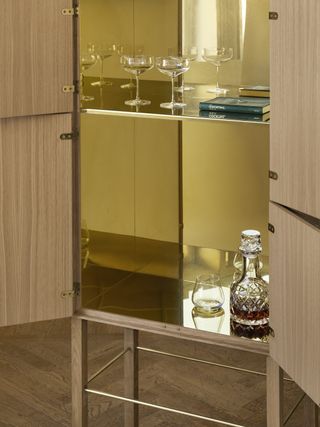
The Eriksberg Cabinet is made with Solid oak. Doors in black bishop diabase. Clamps in brass. Inside is lined in brass. Undercarriage support in brass.
W*: The Tulip is a special piece – tell us more.
CPB: As we know in northern Europe it gets dark, so we love our candles. We think of this as a design portrait of a tulip. Tulips have a fascinating history – they are such a powerful emblem as well as a beautiful flower.
OK: In our design work we like to remove rather than add; we believe that the more you remove the closer you get to the essence of something. With our Tulip candle holder, we have reduced the form to be as simple as possible, while still recognisable. It can take a long time to get to a place of beautiful simplicity!
W*: On that point, how do you work together - do you have individual skills and an established process?
CPB: We have about ten conversations going on at any time. We share things we both appreciate with each other and, though we’re not together sitting in a studio the whole time, we come together a lot throughout the design process.
OK: Without wanting to sound pretentious, we are interested in each other’s ideas. It’s an important part of working as a duo. Over the past 12 years since we started working together, it has only ever been the two of us. We’ve been quite stubborn in that sense. We take our time to get things right.
CPB: Our work is scrutinised, which is a good thing. We don’t let anything go that we are not 100% sure that we wouldn’t want to live with in our own homes. We do the best we can together and we do it our own way.
OK: We like it this way; it means we sleep well at night.
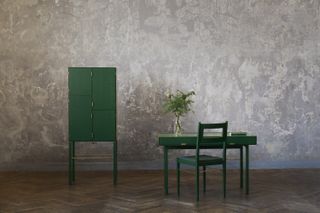
The Eriksberg Cabinet Writing Desk and Chair in Ivy
W*: How do you let go of a design, or know when it is finished?
CPB: It’s not easy a lot of the time. The fastest project we have done was probably a year, still. It always feels scary letting go.
OK: As a designer, you have to embrace the scary part. I believe it makes you a better designer. If you embrace the fear, you make bold decisions, which brings a positive energy to the process. Obviously there are important responsibilities such as timelines and budgets to take into account, but leaving room for feelings of fear and courage is important too.
W*: Please complete the statement: ‘For us, good design means…’?
CPB: I feel good design is what you use, and love using. We are practical in our approach: form follows function. It would be upsetting for us to spend a lot of time and care designing something that nobody used. Design that you enjoy using finds a way into your heart.
OK: I agree. Useful design is powerful. People talk about their work as being timeless but I always want to point out that it’s not for us (or them) to describe new work as timeless. Surely it’s for our grandchildren to say this, once the matter has been proven to be true?
The Eriksberg collection and The Tulip will be available at the web shop bernadottekylberg.com from September 27, 2024.

Hugo is a design critic, curator and the co-founder of Bard, a gallery in Edinburgh dedicated to Scottish design and craft. A long-serving member of the Wallpaper* family, he has also been the design editor at Monocle and the brand director at Studioilse, Ilse Crawford's multi-faceted design studio. Today, Hugo wields his pen and opinions for a broad swathe of publications and panels. He has twice curated both the Object section of MIART (the Milan Contemporary Art Fair) and the Harewood House Biennial. He consults as a strategist and writer for clients ranging from Airbnb to Vitra, Ikea to Instagram, Erdem to The Goldsmith's Company. Hugo has this year returned to the Wallpaper* fold to cover the parental leave of Rosa Bertoli as Global Design Director.
-
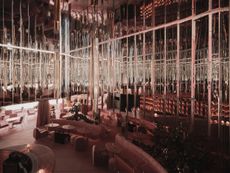 Step inside Koumkan, Athens’ new bar of moody glamour and whimsy
Step inside Koumkan, Athens’ new bar of moody glamour and whimsyDesigned by Manhattan Projects, Koumkan’s interiors blend austere yet glamorous flair, evoking the mood of an inter-war bar
By Daven Wu Published
-
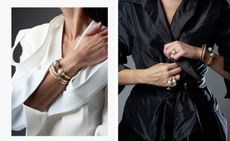 Nada Ghazal's textured gold brings a modern pop to pearls
Nada Ghazal's textured gold brings a modern pop to pearlsNada Ghazal unveils a new jewellery collection, 'Pop of Hope'
By Hannah Silver Published
-
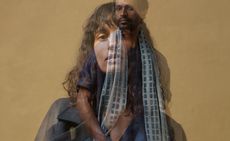 ‘We created our own island’: a new exhibition sees discrete Belgian fashion label Jan-Jan Van Essche step into the spotlight
‘We created our own island’: a new exhibition sees discrete Belgian fashion label Jan-Jan Van Essche step into the spotlightDal Chodha travels to Belgium to meet Jan-Jan Van Essche, the subject of a new exhibition at Antwerp’s MoMu that sheds light on the under-the-radar designer, whose eponymous label marries subtle, discrete elegance with extraordinary fabrications
By Dal Chodha Published